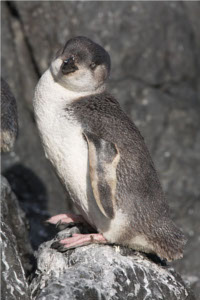White-flippered penguin facts for kids
Quick facts for kids White-flippered penguin |
|
|---|---|
 |
|
| White-flippered Penguin | |
| Conservation status | |
| Scientific classification | |
| Kingdom: | |
| Class: | |
| Order: | |
| Family: | |
| Genus: |
Eudyptula
|
| Trinomial name | |
| Eudyptula minor albosignata |
|
The white-flippered penguin (Eudyptula minor albosignata) is a special type of subspecies of the little penguin. Their name comes from the unique white edges on their flippers, which look like small wings. These small penguins are only found in a specific part of New Zealand.
About the White-flippered Penguin
White-flippered penguins are known for being very small. They are a subspecies of the little penguin, which is the smallest penguin species in the world. They have a blue-grey back and a white belly. The white edges on their flippers make them easy to tell apart from other little penguins.
What Do White-flippered Penguins Look Like?
These penguins are quite small, usually standing about 30 centimeters (12 inches) tall. They weigh around 1.5 kilograms (3.3 pounds). Their feathers are a dark blue-grey on their backs and heads. Their chests and bellies are pure white. The most special feature is the clear white border on their flippers. This white border is what gives them their name.
Where Do White-flippered Penguins Live?
White-flippered penguins live only in a small area of New Zealand. They are mostly found around the Banks Peninsula and Motunau Island on the east coast of the South Island. They spend most of their lives in the ocean, hunting for food. When it's time to nest, they come ashore. They often build their nests in burrows or rocky crevices along the coast.
What Do White-flippered Penguins Eat?
Like all penguins, white-flippered penguins are carnivores, meaning they eat meat. Their main diet consists of small fish, such as sardines and anchovys. They also eat small squid and other tiny sea creatures. They are excellent swimmers and divers, using their strong flippers to chase down their prey underwater. They can hold their breath for a few minutes while hunting.
Life Cycle and Reproduction
White-flippered penguins usually start breeding when they are two or three years old. The breeding season typically runs from September to February. They form pairs and often return to the same nesting sites each year.
Nesting and Eggs
Female penguins usually lay two eggs in a burrow or a sheltered spot. Both parents take turns incubating the eggs, which means sitting on them to keep them warm. This period lasts for about 35 days. While one parent is on the nest, the other goes out to sea to find food.
Chicks and Fledging
Once the chicks hatch, both parents work hard to feed them. They bring back small fish and other food from the ocean. The chicks grow quickly. After about 50 to 60 days, the young penguins are ready to leave the nest. This is called fledging. They will then go out to sea to find their own food and learn to survive.
Are White-flippered Penguins in Danger?
The white-flippered penguin is considered an endangered species. Their population is quite small, and they face several threats.
Threats to Their Survival
- Predators: On land, introduced predators like stoats, ferrets, and cats can hunt adult penguins and their chicks.
- Habitat Loss: Their nesting areas can be lost due to human development along the coast.
- Fishing: Sometimes, penguins can get caught accidentally in fishing nets.
- Climate Change: Changes in ocean temperatures can affect the availability of their food sources.
Conservation Efforts
Many people are working to protect white-flippered penguins. Conservation groups help by:
- Creating safe nesting areas.
- Controlling predators in penguin habitats.
- Educating people about how to protect these special birds.
- Monitoring their populations to understand how they are doing.
By understanding these amazing birds and the challenges they face, we can help ensure they continue to thrive in New Zealand's waters.
See also
 In Spanish: Pingüino azul para niños
In Spanish: Pingüino azul para niños


